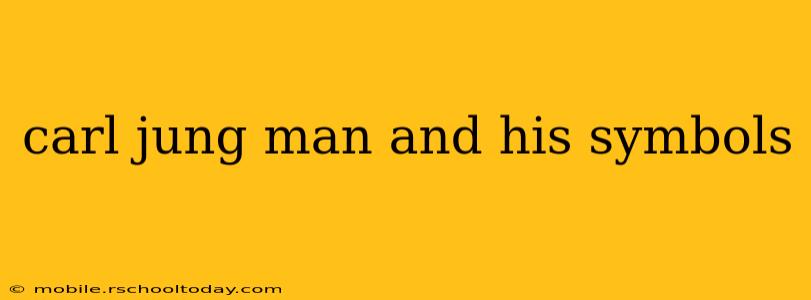Carl Jung, a Swiss psychiatrist and psychoanalyst, remains a towering figure in the field of psychology. His groundbreaking work delved into the depths of the human psyche, exploring the unconscious mind and its powerful influence on our lives. His book, Man and His Symbols, serves as an accessible introduction to his complex theories, making the often esoteric concepts of Jungian psychology understandable to a wider audience. This exploration will delve into the core tenets of Jungian thought as presented in Man and His Symbols, focusing on the significance of symbols and their role in understanding the self.
Understanding the Collective Unconscious
Central to Jung's theories is the concept of the collective unconscious, a universal, inherited layer of the unconscious mind shared by all humankind. Unlike Freud's focus on personal experiences shaping the unconscious, Jung posited a deeper, primordial level containing archetypes – universal, symbolic patterns of behavior and experience. These archetypes aren't simply inherited ideas; they are powerful, symbolic images that influence our dreams, fantasies, and even our waking lives. Man and His Symbols beautifully illustrates this through various examples, drawing connections between seemingly disparate cultures and their symbolic expressions.
The Power of Archetypes
Jung identified several key archetypes, each carrying profound psychological significance. Some of the most prominent include:
- The Self: The archetype representing wholeness and integration of the personality. It's the striving towards individuation – the process of becoming a fully realized self.
- The Shadow: The dark side of the personality, containing repressed aspects and instincts. Understanding and integrating the shadow is crucial for personal growth.
- The Anima/Animus: Representing the feminine within the male (anima) and the masculine within the female (animus). These archetypes influence our relationships and understanding of the opposite gender.
- The Persona: The social mask we wear, the role we present to the world. While necessary for social interaction, an over-identification with the persona can hinder genuine self-expression.
Symbols: The Language of the Unconscious
Jung saw symbols as the primary means by which the unconscious communicates with the conscious mind. They are not arbitrary; rather, they carry deep meaning and significance, often revealing underlying psychological processes. Man and His Symbols utilizes vivid examples from mythology, religion, art, and dreams to demonstrate how symbols operate, showing how seemingly disparate images can convey universal themes.
Interpreting Symbols: A Personal Journey
Interpreting symbols isn't a mechanical process. Jung emphasized the importance of individual experience and context in understanding the symbolic language of the unconscious. While some symbols possess common archetypal meanings, their personal significance varies depending on the individual's unique life experiences and psychological makeup.
The Significance of Dreams
Dreams, according to Jung, offer a crucial window into the unconscious. They are not simply random firings of neurons but meaningful expressions of the psyche, often utilizing symbols to communicate unresolved conflicts, repressed emotions, and aspirations for growth. Man and His Symbols provides insightful interpretations of various dream scenarios, highlighting the symbolic language used by the unconscious to convey its messages.
Active Imagination: Engaging with the Unconscious
Jung developed the technique of active imagination to engage directly with the unconscious. This involves consciously interacting with images and symbols arising from dreams, fantasies, or spontaneous imagery. This method, outlined in Man and His Symbols, allows individuals to engage in a dialogue with their unconscious, promoting self-awareness and personal growth.
Conclusion: A Legacy of Understanding
Carl Jung's work, particularly as presented in Man and His Symbols, remains highly relevant today. His exploration of the unconscious, the power of symbols, and the process of individuation continues to provide invaluable insights into the human experience. By understanding the symbolic language of the unconscious, we can unlock deeper levels of self-awareness and embark on a journey toward greater psychological wholeness. The enduring legacy of Jung lies in his ability to make the complexities of the human psyche both understandable and accessible, inspiring countless individuals to explore the depths of their own being.
